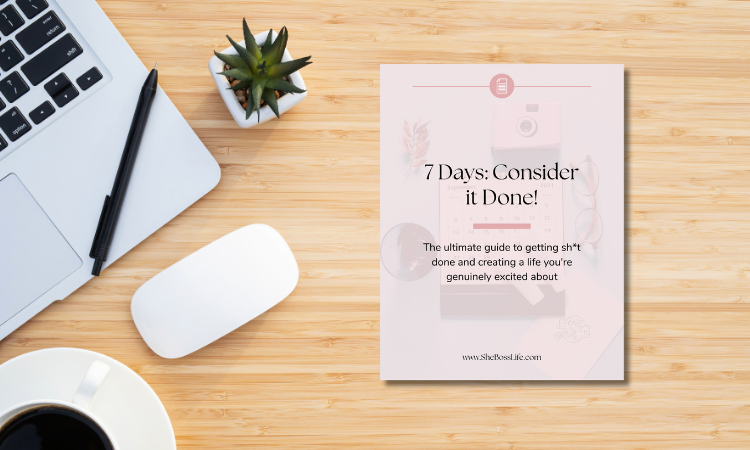How to Use Productive Meditation to Get More Done
The goal of increasing your productivity can quickly go awry.
In the pursuit of productivity, you may find yourself productively procrastinating.
You know, that’s where your house gets clean…but only because you’re avoiding finishing the next chapter of the book you’ve been promising yourself for years you’d get around to writing. You’re staying “busy” which fills your desire for productivity. But, you’re never getting to the things that will have a real impact on your big goals.
You may also find yourself falling into habits of toxic productivity.
This time management trap finds you believing your main accomplishment in life is judged by the number of tasks you can strike off the to-do list. You forget to enjoy the present moment because you’re too busy filling up every minute with some sort of activity, feeling guilty anytime you’re sitting still.
Simply increasing your productivity for the sake of being more productive isn’t likely to lead to a more fulfilling life or meaningful achievements.
Productivity also isn’t a great problem solver when it comes to goal setting and creating an intentional life you’re excited to live. Tackling the big stuff requires deep thought and calculation as you weigh your options. When you focus only on being a productive slave to your task list, that leaves little room for growth. And can even lead to problems piling up, causing you to feel more overwhelmed than ever.
“Don’t measure your productivity by the hours, but by the results”
Bernard Kelvin Clive, Author
Luckily, there is a different route to productivity that is sure to have a bigger impact:
It’s called: productive meditation.
What is Productive Meditation
Productive meditation, as described in the book Deep Work by Cal Newport, involves focusing your mind on a specific problem or project while engaging in activities that require very low mental demand.
Productive meditation is not sitting cross-legged in a quiet room chanting mantras. Instead, you leverage the time you’re already spending on low-demand activities (such as walking or driving or light exercise) to focus your mind on a problem that needs solving.
The goal of productive meditation is to train your brain to think creatively. This allows you to solve problems more effectively by providing dedicated mental space for deep thinking and reflection during these routine activities.
When you schedule time only to work on completing tasks from your to-do list, the tasks will get done. But you don’t leave much room to think bigger picture, rethink the status quo, or makenew connections between concepts and ideas that may just be the inspiration you need for big change.
This is where productive meditation comes in.
Time for productive meditation is when the only “productive” thing you need to get done is to think. Problem-solve, brainstorm, plan...etc. It’s free thinking without the constraints of a specific outcome.
How to Use Productive Meditation
You can easily tap into this secret productivity hack as part of your current schedule.
Here’s how:
Step 1: Pick Your Problem
Think about a challenge you’re facing at work or a project you’re trying to tackle. It could be anything from figuring out how to streamline your workflow, coming up with a catchy slogan for your latest marketing campaign, or even deciding if now is the best time for a career move.
Step 2: Choose Your Low-Demand Activity
Once you’ve got your problem in mind, find an activity that doesn’t require a ton of brainpower but keeps your body busy. The low-demand activity could be going for a walk, your daily commute, or folding laundry. You could even devote a morning journaling session to some productive meditation.
To make it easy, try to find an activity you already do regularly instead of trying to add something new to your schedule.
Step 3: Let Your Mind Wander
Now, as you’re doing your chosen low-demand activity, let your mind wander and start thinking about your problem. Don’t judge or try to force any solutions or ideas, just let your thoughts flow naturally.
Step 4: Capture Your ‘Aha’ Moments
Keep an open mind and be on the lookout for those "aha" moments when a brilliant idea pops into your head. They might come when you least expect them, so be ready to jot them down or make a mental note. Keep a notebook or the notes app on your phone handy to capture any epiphanies.
Step 5: Rinse and Repeat
Practice makes perfect, so make productive meditation a regular part of your routine. The more you do it, the better you’ll get at tapping into your brain’s creative power and the more progress you’ll start to make on the big stuff.
Why it Matters
Incorporating productive meditation into your daily routine is a simple yet powerful way to unlock your full potential and live a more fulfilling life.
Productive meditation allows you to give your brain the time and space it needs to consider complex problems. By allowing your thoughts to wander freely, you may stumble upon creative solutions that you wouldn’t have considered otherwise.
Productive meditation can also have profound internal effects. By taking the time to reflect on your thoughts and feelings, you can gain a deeper understanding of yourself and your motivations. This increased self-awareness can help you make more informed decisions about your life.
The next time you’re feeling overwhelmed by your to-do list or a problem that just seems unsolvable, take a deep breath, find your focus, and let your brain do its thing. You’ve got this!
If you liked this post, don’t forget to share so that others can find it, too.
About Me
Hi, I’m Kara. I’m a former workaholic turned time-management expert. I help women stressed out in their 9-5 get more done, in less time, so they can get back in the driver’s seat and start living a life they love.



